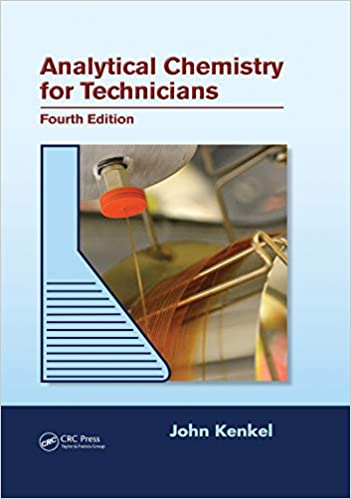Titration of sodium hydroxide with hydrochloric acid
general remarks
Determination of sodium hydroxide concentration is about as often discussed as hydrochloric acid titration - both acid and base are strong, so calculation of titration curve and equivalence point are pretty straightforward. However, titration itself is not as easy. Sodium hydroxide easily adsorbs carbon dioxide from the atmosphere, and presence of carbonic acid interferes with the end point detection. Titration - as described - allows determination of initial amount of sodium hydroxide, that is ignore carbon dioxide presence.
reaction
This is a simple neutralization reaction:
HCl + NaOH → NaCl + H2O
or
H+ + OH- → H2O
See hydrochloric acid determination for more details.
sample size
Depending on the titrant concentration (0.2 M or 0.1 M), and assuming 50 mL burette, aliquot taken for titration should contain about 0.28-0.36 g (0.14-0.18 g) of sodium hydroxide (7-9 or 3.5-4.5 millimoles).
end point detection
Equivalence point of strong acid titration is usually listed as exactly 7.00. That's not necesarilly the case, as it depends on the solution temperature and ionic strength of the solution, besides, slight hydrolysis of NaOH shifts pH down by about 0.02 unit. Not that it changes much - we are still very close to 7. However, as we have discussed on the acid-base titration end point detection page, unless we are dealing with a diluted solution (in the range of 0.001 M) we can use almost any indicator that gives observable color change in the pH 4-10 range. Lab practice shows that the most suitable and easy to use indicator in this case is methyl orange.
If sodium hydroxide is contaminated with sodium carbonate - which is not rare - added titrant reacts first with hydroxide and later protonates weaker bases - carbonate:
CO32- + H+ -> HCO3-
and then hydrogen carbonate:
HCO3- + H+ -> H2CO3
Presence of carbonic acid shifts pH of the solution down, which may effect in premature end point detection. To avoid this problem, we should titrate the solution to the end point (first sign of red tint), then heat the solution to boil to remove CO2. If at this stage color of the solution changes back to yellow, we should cool it and titrate again. Depending on the amount of carbonates present we may have to repeat the procedure more than once.
solutions used
To perform titration we will need titrant - 0.2 M or 0.1 M hydrochloric acid solution, indicator - methyl orange and some amount of distilled water to dilute sodium hydroxide sample.
procedure
- Pipette aliquot of sodium hydroxide solution into 250mL Erlenmeyer flask.
- Add about 70 mL of distilled water.
- Add 1-2 drops of methyl orange solution.
- Titrate with hydrochloric acid solution till the first color change.
- Heat the solution to boil to remove dissolved carbon dioxide. Solution may change color back to yellow.
- Titrate with HCl solution till the first color change. Repeat titration and boiling till yellow color doesn't return after cooling the solution.
result calculation
According to the reaction equation
HCl + NaOH → NaCl + H2O
Hydrochloric acid reacts with sodium hydroxide on the 1:1 basis. That makes calculation especially easy - when we calculate number of moles of HCl used it will be already number of moles of NaOH titrated.
To calculate sodium hydroxide solution concentration use EBAS - stoichiometry calculator. Download determination of sodium hydroxide concentration reaction file, open it with the free trial version of the stoichiometry calculator.
Click button above HCl in the input frame, enter volume and concentration of the titrant used. Click button. Read number of moles and mass of sodium hydroxide in the titrated sample in the output frame. Click button in the output frame below sodium hydroxide, enter volume of the pipetted sample, read sodium hydroxide concentration.
Note that presence of carbonates - while interferes with the end point detection - doesn't interfere with the determination of initial amount of sodium hydroxide. However, if we want to determine amount of sodium hydroxide that was not yet neutralized by carbon dioxide, we should titrate the solution against two indicators, this is so called Warder's method which we will discuss separately.
sources of errors
Carbon dioxide interferes with the determination (end point detection) as described above. During heating, if the solution is allowed to boil too vigorously, it may splash and some sodium hydroxide can be lost. Titration - as described - doesn't allow to determine amount of sodium hydroxide that was not yet reacted with carbon dixode. Otherwise - just the general sources of titration errors





